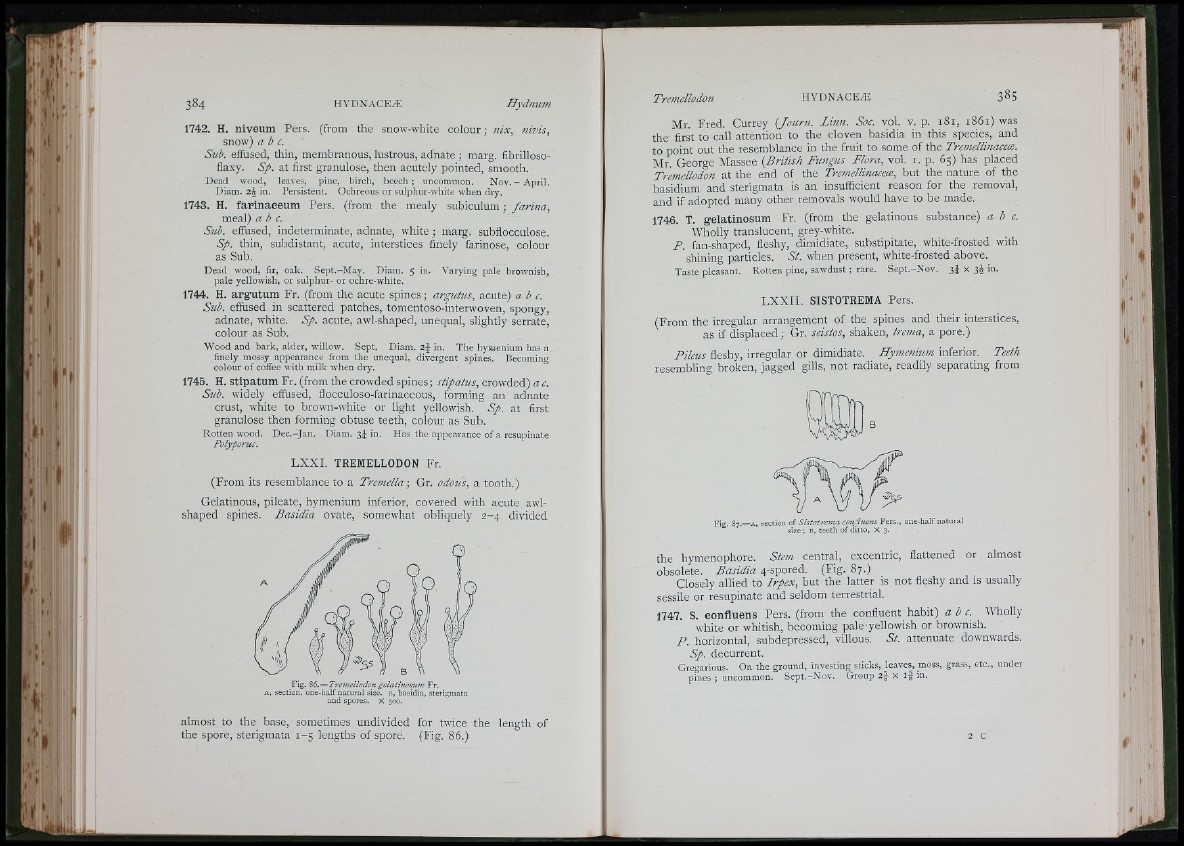
Sí
1742. H. niveum Pers. (from the snow-white colour; nix, nivis,
snow) abc.
Sub. effused, thin, membranous, lustrous, adnate ; marg. fibrilloso-
flaxy. Sp. at first granulose, then acutely pointed, smooth.
Dead wood, leaves, pine, birch, beech ; uncommon. Nov. - April.
Diam. 2® in. Persistent. Ochreous or sulphur-white when dry.
1743. H. farinaeeum Pers. (from the mealy subiculum ; farina,
meal) abc.
Sub. effused, indeterminate, adnate, white ; marg. subflocculose.
Sp. thin, subdistant, acute, interstices finely farinose, colour
as Sub.
Dead wood, fir, oak. Sept.-May. Diam. 5 in. Varying pale brownish,
pale yellowish, or sulphur- or ochre-white.
1744. H. argutum Fr. (from the acute spines; argutus, acute) abc.
Sub. effused in scattered patches, tomentoso-interwoven, spongy,
adnate, white. Sp. acute, awl-shaped, unequal, slightly serrate,
colour as Sub.
Wood and bark, alder, wdllow. Sept. Diam. 2® in. The hymenium has a
finely mossy appearance from the unequal, divergent spines. Becoming
colour of coffee with milk when dry.
1745. H. stipatura Fr. (from the crowded spines; stipatus, crowded) a c.
Sub. widely effused, flocculoso-farinaceous, forming an adnate
crust, white to brown-white or light yellowish. Sp. at first
granulose then forming obtuse teeth, colour as Sub.
Rotten wood. Dec.-Jan. Diam. 3® in. Has the appearance of a resupinate
Polyporus.
LXXI. TREMELLODON Fr.
(From its resemblance to a Tremella ; Gr. odous, a tooth.)
Gelatinous, pileate, hymenium inferior, covered with acute awl-
shaped spines. Basidia ovate, somewhat obliquely 2-4 divided
Fig. 86.— Treiuellodoii g elatinosum Fr.
A , s e c t i o n , o n e - h a l f n a t u r a l s i z e , b , b a s i d i a , s t e r i g m a t a
and spores. X 500.
almost to the base, sometimes undivided for twice the length of
the spore, sterigmata 1-5 lengths of spore. (Fig. 86.)
Mr. Fred. Currey {fourn. Linn. Soc. vol. v. p. 181, 1861) was
the first to call attention to the cloven basidia in this species, and
to point out the resemblance in the fruit to some of the Tremellinacem.
Mr. George Massee {British Fungus Flora, vol. i. p. 65) has placed
Tremellodon at the end of the Tremellinaceoi, but the nature of the
basidium and sterigmata is an insufficient reason for the removal,
and if adopted many other removals would have to be made.
1746. T. gelatinosum Fr. (from the gelatinous substance) a b c .
Wholly translucent, grey-white.
P. fan-shaped, fleshy, dimidiate, substipitate, white-frosted with
shining particles. St. when present, white-frosted above.
Taste pleasant. Rotten pine, sawdust; rare. Sept.-Nov. 3® X 3® in.
LXXII. SISTOTREMA Pers.
(From the irregular arrangement of the spines and their interstices,
as if displaced; Gr. seistos, shaken, trema, a pore.)
Pileus fleshy, irregular or dimidiate. Hymenium inferior. Teeth
resembling broken, jagged gills, not radiate, readily separating from
■ f
Fig. 87.—A, section of S isto trem a condue^is Pers., one-half n atural
siz e ; B , teeth o f ditto, X 3.
the hymenophore. Stem central, excentric, flattened or almost
obsolete. Basidia 4-spored. (Fig. 87.)
Closely allied to Lrpex, but the latter is not fleshy and is usually
sessile or resupinate and seldom terrestrial.
1747. S. eonfluens Pers. (from the confluent habit) a b e. Wholly
white or whitish, becoming pale yellowish or brownish.
P. horizontal, subdepressed, villous, St. attenuate downwards.
Sp. decurrent.
Gregarious. On the ground, investing sticks, leaves, moss, grass, etc., under
pmes ; uncommon. Sept.-Nov. Group 2f X i f in.
2 C